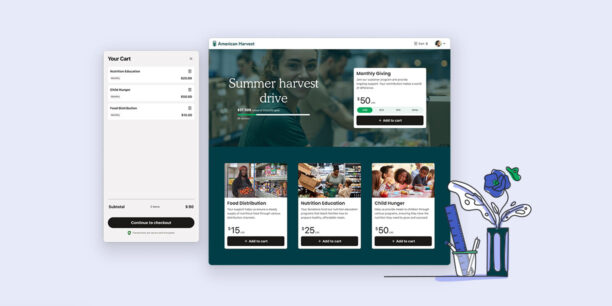5 Facebook Fundraising Tips for Nonprofits

Request a Demo
Learn how top nonprofits use Classy to power their fundraising.
Facebook has 2.45 billion monthly active users, making it the biggest social network worldwide. It’s also the world’s third most visited website and 74% of all Facebook users log in to their accounts on a daily basis, where those users spend roughly 38 minutes per day using the platform.
More impressive than the stats that prove, without a doubt, that Facebook is massively popular and frequently used by people all over the world are the platform’s engagement statistics. These are especially important for nonprofits that want to use Facebook in partnership with their fundraising efforts. Check it out:
- Across all Facebook posts, there is an average engagement rate of 3.6%
- The average organic reach of a Facebook post is 5.5%
- Video posts get an average engagement of 6.13%
These data points show us that people are not only using Facebook in their daily routine, but they’re also actively engaging with content they see. Still, given the sheer amount of people using Facebook, there’s a lot of noise that your nonprofit needs to cut through in order to get fundraising campaigns, appeals, and updates heard.
Below, we rounded up 5 Facebook fundraising tips that can help you get noticed by the masses. Before we explore the Facebook fundraising tips though, it’s important to understand why you should consider fundraising on Facebook in the first place.
Fundraising With Facebook
Fundraising directly on Facebook with their own tools, or promoting links to your fundraising campaigns hosted on other platforms like Classy, can help you quickly and easily reach a lot of new people. In many ways, it’s a similar concept to peer-to-peer fundraising platforms.
You share your link with one person, who shares it with five more, who each share it with five more, and so on. The result is an exponential increase in the amount of people who see your fundraising campaign. Further, since you might not be directly connected to these individuals, you’re simultaneously expanding your brand to new audiences of potential supporters.
What’s more, 46% of survey respondents in our special report, Why America Gives, say they choose to donate to a cause if a family member or friend asks them to. In addition, 50% state that a friend or family member being personally affected by a cause would motivate them to give. When someone shares your campaign on social media, it plays right into this and adds a strong element of social proof that could encourage someone to make a donation.
1. Update Your Profile
People form first impressions about other humans within seconds of meeting them. The same holds true for your nonprofit, and your Facebook page is where people might engage with your organization for the first time. It’s mission-critical to have a page that grabs someone’s attention, provides them with all the relevant information they need to know, and showcases your best content.
Above all else, make sure you use a high resolution cover photo on your page. Even if it’s the slightest bit blurry, we recommend you swap it out for a sharp, crisp, and clean image. Also, you should also size it 820 pixels by 360 pixels in order to have it display properly on both desktop and mobile.
Aside from your photo, make sure your “About” section is up to date. This is the one-stop-shop for people to find out everything they need to know about your nonprofit, from founding story to how they can reach you. This means you need to:
- Include your mission statement
- Provide up-to-date contact information
- Add an overview of your nonprofit
- Post important milestones in your history
- Tell your story
Last, make sure you have a simple, straightforward “@” tag that goes along with your profile. This is how people are going to tag you in posts across Facebook, so make sure they can easily do so. We suggest simply doing @[INSERT YOUR NONPROFIT NAME].
It’s not enough to build a good Facebook page and then immediately start posting. You need to define a Facebook fundraising strategy that outlines:
- What goals you intend to accomplish
- How you plan to meet those goals
- The daily, weekly, or monthly cadence you plan to post on
- Best practices for interacting with other Facebook users
- Important metrics to track
Without a targeted social media campaign strategy, your important messages might not be seen by as many people as you want. Moreover, if you don’t know what you’re tracking toward, you won’t know what parts of your strategy to double down on or pivot away from. Here’s a quick look at what a social campaign strategy could look like:
- We will spread the word about our new recurring giving program to Facebook in order to drive 50 new signups over six months
- Our team will post in specific Facebook groups relevant to our cause and ask current recurring donors to share with their network
- Five posts each week will be dedicated specifically to this recurring giving program initiative, and each will contain a link with source codes
- When people comment, we will have a member of our staff dedicated to responding to their questions, concerns, or praise
- Success metrics include link clicks, re-shares, comments, and recurring giving program signups
3. Create Solid Content
Once your social strategy is firmly in place, you can drill down into the specific types of content you’ll promote to your Facebook audience. It can be tempting to write one strong post, copy and paste it into your social media scheduling tool, and call it a day. However, that can end up hurting more than it helps.
If people see the same message, verbatim, repeated over and over again they’re going to lost interest and abandon your page. Instead, get creative and think of the different ways you can promote the same message.
Let’s say your core message is “Sign up for our recurring giving program.” You can, and should, do a straightforward post that announces your program and that you’re looking for people to support it. Beyond that, you can drive supporters to your program with other posts about the impact they can make, beneficiary stories, or why the program is important to your continued mission.
Additionally, consider how you might activate your supporters to provide user-generated content for your recurring giving program. They might write blog posts about their experiences with your nonprofit, share photos of their volunteer activities, or write organic social posts.
4. Focus on Engagement
When your post starts to light up with interaction, it’s easy to get caught up in the vanity metrics, which look good on paper but don’t always translate into anything meaningful. For example, high impressions and reach indicate that your post is being seen by a lot of people, but what does that actually mean? Are any of these people reading the content? Do the photos grab their interest?
Awareness metrics like impressions and reach don’t give you a full picture. Instead, focus on the engagement metrics for your posts: likes, shares, and comments. These are concrete actions someone takes when they see your Facebook post in their feed, and they offer a more stable footing to analyze the success of your content.
Plus, Facebook’s algorithm prioritizes posts that have higher engagement over those that do not. That is, when your post gets more likes, shares, and comments, it has a higher chance of appearing in a wider grouping of Facebook feeds. The algorithm is constantly changing, make sure you informed of the latest updates.
5. Partner With Influencers
The Facebook conversation might seem moot if you don’t have a large audience to promote your fundraising initiatives to, but don’t be discouraged. The exciting part about Facebook is that there are countless new audiences for you to break into with the right leverage.
In some cases, your point of entry into these new circles are social media influencers. These are the individuals or companies who have followers that number in the thousands or, in some cases, millions. Partnering with these social media influencers might seem like a lofty pipe dream at first, but you’d be surprised how often they want to work with brands that prioritize social impact.
The key is to partner with the right influencers who align with your brand, are passionate about your cause, and have highly engaged audiences. Beyond that, you’ll need to offer a value proposition that is mutually beneficial for both parties: they’re offering you their reach, so what can you offer in return? Maybe you can give them tickets to your next event, free swag, or exclusive volunteer opportunities.
Remember, social media influencers will be an extension of your brand. Partner with the ones who are “real” and actually care, even if it means a smaller audience reach.
BONUS: Use the Classy for Facebook Integration
Classy has an integration with Facebook that empowers your supporters to raise more money while also extending the reach of your organization to new audiences of potential donors. Classy for Facebook is a direct integration into Facebook fundraising that allows supporters to duplicate their personal fundraising page on Classy to Facebook in just a few clicks.
Peer-to-peer fundraisers can solicit for donations either through their personal fundraising page, their Facebook fundraising page, or both. Regardless, the campaign progress remains in sync as all the data flows back through your original campaign page and into Classy Manager. Be sure to download our guide and master this integration today.
Free Download: Classy + Facebook—A Guide to Boosting Fundraiser Retention
Don’t look at Facebook as just a social media platform. Shift your perspective to view it as a powerful lever your marketing team can pull to reach new audiences, increase brand awareness, promote your fundraising campaigns, and ultimately drive more fundraising revenue.
As you go, use these Facebook fundraising tips to help navigate the platform as you build out your marketing strategy. And if you have any other important tips please share them with us in the comments below.

The BIG Guide to Social Media for Nonprofits
Subscribe to the Classy Blog
Get the latest fundraising tips, trends, and ideas in your inbox.
Thank you for subscribing
You signed up for emails from Classy
Request a Demo
Learn how top nonprofits use Classy to power their fundraising.
 Explore Classy.org
Explore Classy.org 

